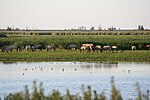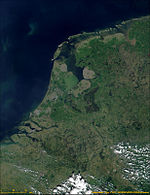H. Wortman Pumping Station
Industrial buildings in the NetherlandsInfrastructure completed in 1956Interlanguage link template existing linkLelystadPumping stations ... and 1 more
Use Oxford spelling from July 2024

The H. Wortman Pumping Station (Dutch: Gemaal H. Wortman) is a pumping station in Lelystad, Flevoland, the Netherlands. Named for Hendrik Wortman, a civil engineer who contributed to the Zuiderzee Works, the station was designed by Dirk Roosenburg and completed in 1956. It was used for the reclamation of the eastern Flevopolder in 1957, and contributed to the reclamation of the polder's southern areas. It was declared a municipal monument in 2017.
Excerpt from the Wikipedia article H. Wortman Pumping Station (License: CC BY-SA 3.0, Authors, Images).H. Wortman Pumping Station
Houtribweg, Lelystad
Geographical coordinates (GPS) Address Nearby Places Show on map
Geographical coordinates (GPS)
| Latitude | Longitude |
|---|---|
| N 52.50295 ° | E 5.42055 ° |
Address
Houtribweg
Houtribweg
8243 PB Lelystad
Flevoland, Netherlands
Open on Google Maps











